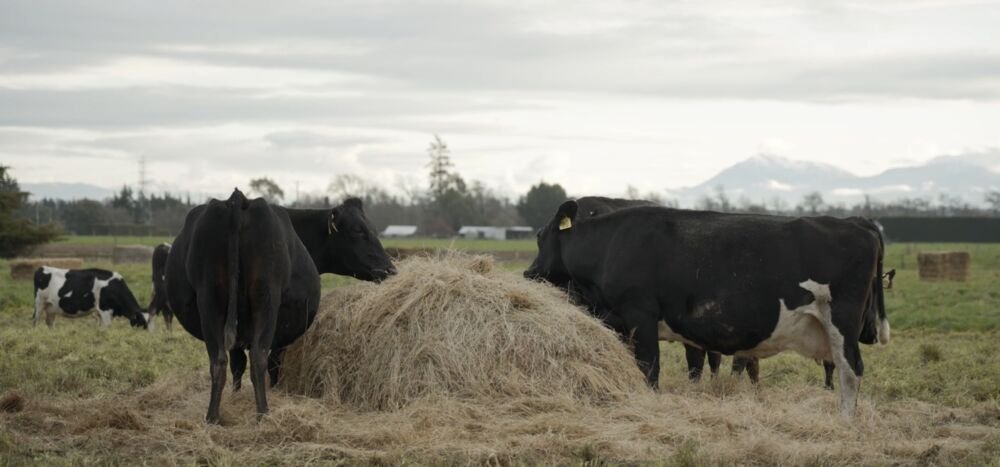Hay bale grazing: A best practice guide
This guide follows our previous post differentiating hay bale grazing and bale grazing. At the request of our community, we’ve compiled technical information on implementing hay bale grazing.
This information purely acts as a best practice guide, providing principles and considerations for farmers taking a holistic approach to their farming system. This is not a recipe on how to do hay bale grazing. Quorum Sense advocates holistic management practices that consider the health of the whole farm system. The considerations listed below are based on observations, learnings and research from New Zealand farmers and soil scientists.
Hay bale grazing is used as a way of supplementing ruminant animals stockpiled through the non-growing season. When managed appropriately, benefits can include improved soil health, increased soil organic matter and water holding capacity, plus the emergence of greater plant diversity. The litter (mulch) left behind acts as a warm area for animals to rest, and later in the spring, it can acts as nesting areas for birdlife.




Design and management considerations
These guidelines are based on mixed aged dairy cows and R2 heifers
Before you start
Shut up paddocks early enough to have 3,000-4,000 kgDM/ha pre-grazing cover (March-early April depending on timing of grazing)
Set out hay bales in a grid formation at approx. 20-30 bales/ha (if using 4-6 ft bales). When budgeting, allow 15-20% extra to what is needed in theory to allow for wetter conditions and managing and minimising pasture damage (7-10 cows can roughly loaf on a 4-6 foot bale when it has been flattened by the cows).
Try placing bales in a different position in the same paddock each year to eventually cover the whole paddock with bale litter over 3-4 winters / grazings.
An efficient form of moving temporary troughs around is essential to allow back fencing of previous breaks.
Management of each break
Grazing method (as an example, but not limited to) - 100 cows offered 1⁄2 ha every three days (back-fenced and offered water, use square breaks where possible).
Leave bale on round, taking off netting before feeding break (on steeper slopes, roll onto side to prevent rolling off down the hill from playful cows).
Modest grazing pressures are applied. These are equivalent to about 16 m2/cow/day; or using the standardised metrics we now use, equivalent to about 0.5 Relative Stock Units per m2/day. These pressures are about half that imposed on areas used for winter forage crop grazing (albeit this depends on crop yields and allocation).
Set stocking - the three-day shift ensures back-fencing is always implemented, and clean breaks are frequently offered.
Paddock selection and management
Paddock selection is important. Harder to do on steep sidings.
Established pastures are used, which provide more armour than recently cultivated and newly sown paddocks.Well-drained soil types and low-ish (< 200 mm) winter rainfall also help.
When wet weather events occur move cows on to the next break earlier, ensuring the soil and pasture is not damaged - this will allow quicker recovery. Come back to the unfinished break once soil conditions allow (dry out).
Sheree & Dylan Ditchfield have bale grazed on freer-draining soils and heavier soils, with little difference so far in the damage to pasture.
Bale selection and setup
Hay bales: 4ft x 4ft or 5ft x 4ft round bales work best.
Feed WITHOUT bale racks - cows eat approx. 80% of bale, leaving 20% as bale litter.
Seed in the bale is important to achieve natural reseeding after the bale litter breaks down.
Keep bales - and water troughs - out of hollows or potential ponding areas.
Thanks to input and experience of farmers, Deane Parker, Mark Anderson, Dylan & Sheree Ditchfield and Soil Scientist, Ross Monaghan for their guidance and expertise in compiling this information.
Further resources and reading:
7min film of hay bale grazing in action.
https://www.quorumsense.org.nz/content/bale-grazing-an-alternative-to-winter-crops
https://www.quorumsense.org.nz/content/bale-grazing-cost-comparison
https://www.agresearch.co.nz/news/soil-armour-tools-to-help-provide-winter-grazing-options/
https://www.sciencedirect.com/science/article/pii/S0022030224007586
*Bale grazing mentions in QS resources refer to hay




